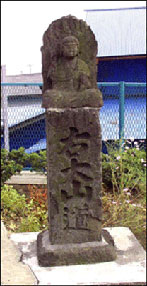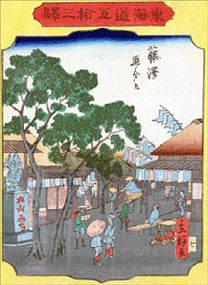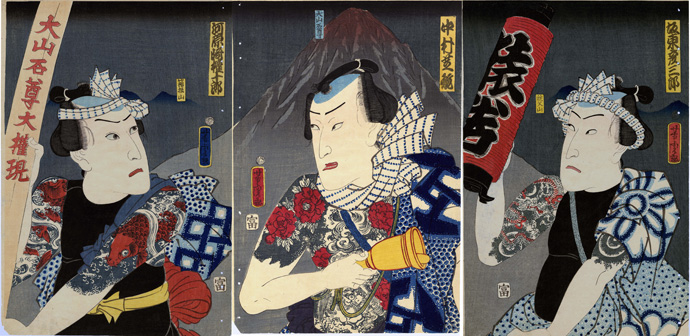公開日 2021年11月12日
Edo Period
Tokugawa Government
Tokugawa Ieyasu was appointed shogun by the emperor and established the shogunate government in Edo in 1603 after he won the Battle of Sekigahara. The long period of internal disturbances was finished and the Edo period, which is called the Reign of Peace, began.
The name of Isehara originated in 1619, the Edo period, when Soemon from Ise-Yamada and Yuasa Izaemon from Kamakura reclaimed the land Senjugahara and invoked the spirit of the Grand Shrine of Ise to come over here.
The development of the industries and land started in this period, too. For example, irrigation channels were made by improving the River Suzu in 1706 by Denbei, the head of Kushihashi and Ogasawara Jurobei, the head of Shirane. The cultivation of tobacco was taught by people in Hadano in the Meireki era (1655 to 1658).


- The stone guidepost remaining along Oyama-michi road in Shimo-Ochiai has the image of Fudo Myo-o on its top.
A similar guidepost is depicted in this woodblock print.
Bustling Oyama
Ieyasu began to reform Oyama-dera Temple when he opened the shogunate in Edo. Oyama-dera Temple at that time had militant monks and mountain priests who came there in the Age of Civil Wars. He expelled them, reshuffled the staff of the temple and then contributed the farmland which could yield 100 koku (500 bushels) of rice a year. The third shogun Iemitsu also donated plenty of money to the temple for its restoration. Lady Kasuga no Tsubone, who was Iemitsu’s nanny, occasionally visited Oyama. The shogunate sent its representatives including her to the temple, as well.
The Oyama pilgrimage became very popular among ordinary people in the mid-Edo period. They came to Oyama in groups to pray to the Shinto spirit Sekison-Daigongen enshrined on the mountain. A short trip like this also provided a chance to do the sights for pleasure, attracting people of Edo when the culture of townspeople started to bloom. Isehara was developed as the gateway to the religious mountain to receive pilgrims. Streets were lined with shops and inns.
The guideposts were set up along the routes to Oyama. Some of them still stand there watching the travelers for their safety. Quite a number of present temples and shrines of Isehara were founded in the Edo period, and most of the Buddhist statues were produced in those days. In the late Edo period, haiku poets and scholars also came to visit and made Isehara a culturally rich place which has nurtured artists and stage performers.

Kabuki actors play roles of pilgrims to Oyama.
Next⇒Meiji, Taisho, and Showa Periods
- Geogaraphical Features of Isehara
- Paleolithic Period
- Jomon Period
- Yayoi Period
- Kofun (Tumulus)Period
- Nara Period
- Heian Period
- Kamakura Period
- Muromachi Period
- Civil War Period
- Edo Period
- Meiji, Taisho, and Showa Periods
Previous⇒Civil War Period


